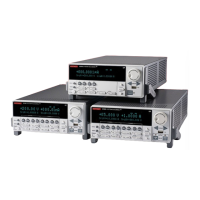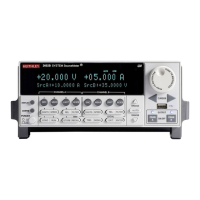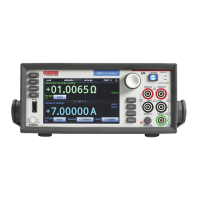12-2 Instrument Control Library Series 2600 System SourceMeters Reference Manual
2600S-901-01 Rev. A / May 2006 Return to Section 12 topics
Command programming notes
Conventions
For the following command reference, it is necessary to understand the following
conventions:
Wild characters
Many SMU commands are expressed in a generic form using wild characters. A
wild character indicates an SMU channel, function or trigger line. Keep in mind
that wild characters used in the generic form are NOT to be included in the
command sent to the instrument.
X and Y
The X character is used for functions and attributes to indicate the SMU channel
(
a or b) and Y is used to indicate the SMU function (v, i, r or p). For example, the
attribute for the source output setting is generically expressed as follows:
smuX.source.levelY
To program SMU channel A to 5 volts, the following command statement is to be
sent to the instrument:
smua.source.levelv = 5.0
To program SMU channel B to 1 milliampere, the following command statement is
to be sent to the instrument:
smub.source.leveli = 0.001
The wild characters X and/or Y are NEVER sent to the instrument. They are used
in this command reference for notational convenience only.
[N]
The N character, enclosed by brackets ([ ]), is used in functions and attributes for
the Digital I/O line (
1 to 14). For example, the function to assert an output trigger is
generically expressed as follows:
digio.trigger[N].assert
To program the Series 2600 to assert an output trigger on trigger line 5, the
following command statement is sent to the instrument.
digio.trigger[5].assert()
The wild character N should NOT to be sent to the instrument. However, the
brackets (
[ ]) must be included in the command. Also, note that the above
command requires that a set of open and closed parenthesis (
()) be appended to
the function (see “
Functions” in following subsection).
